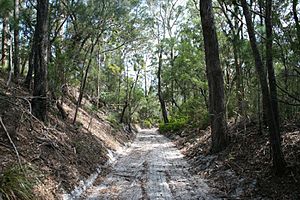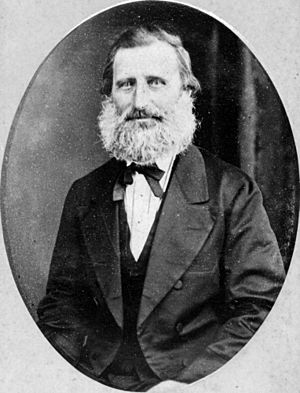Cooloola Tramway facts for kids
Quick facts for kids Cooloola Tramway |
|
|---|---|

Cooloola Tramway, cutting through the forest, 2012
|
|
| Location | Great Sandy National Park, Cooloola Recreation Area, Cooloola, Gympie Region, Queensland, Australia |
| Design period | 1870s - 1890s (late 19th century) |
| Built for | William Pettigrew |
| Official name: Pettigrew's Cooloola Timber Tramway Complex, Cooloola Railway, SEQ-5N 22, Pettigrew's Railway, Pettigrew's Tramway | |
| Type | state heritage (landscape, archaeological, built) |
| Designated | 12 July 2013 |
| Reference no. | 602819 |
| Significant period | 1860s-1884 |
| Significant components | cutting - tramway, embankment - tramway |
| Lua error in Module:Location_map at line 420: attempt to index field 'wikibase' (a nil value). | |
The Cooloola Tramway is a historic railway line located in the Great Sandy National Park in Queensland, Australia. It was built in the 1870s to help move timber. This tramway is also known by other names like Cooloola Railway and Pettigrew's Tramway. It was officially added to the Queensland Heritage Register on 12 July 2013, recognizing its importance to history.
Contents
Discovering the Cooloola Tramway
In the 1860s, a man named William Pettigrew started a business cutting down Kauri pine trees in the Cooloola area. This area was very sandy, and it was hard to use bullocks (oxen) or horses to drag the heavy logs. There wasn't enough food for the animals either.
Pettigrew needed a better way to get the valuable timber out of the forest. His solution was to build a tramway. The Cooloola Tramway opened in October 1873. It was Queensland's first big private railway line.
Why Timber Was So Important
When Europeans first arrived in Queensland, they saw huge forests. These forests were full of softwoods like Hoop pine and Kauri pine. Timber was a very important natural resource. It helped Queensland grow a lot.
William Pettigrew played a big part in this. He came to Australia from Scotland in 1849. He worked as a surveyor, which meant he explored the land. This job helped him learn about the local timber.
Pettigrew's Sawmills
In 1853, Pettigrew opened Queensland's first steam-powered sawmill in Brisbane. A sawmill is a factory that cuts logs into planks of wood. This sawmill was a very important industrial business for Queensland.
Later, in 1863, Pettigrew opened another sawmill called Dundathu near Maryborough. This city also became a major timber town. Pettigrew's sawmills helped supply timber to many places, including Sydney and other towns in Queensland.
The Challenge of Moving Logs
Pettigrew found a lot of Kauri pine trees in the Woolann area of Cooloola. His workers used bullocks to drag the logs to Seary's Creek. From there, the logs were tied together into huge rafts and floated through the water to the Dundathu Sawmill.
But the sandy ground made it very difficult for the bullocks. Pettigrew realized he needed a faster and easier way to transport the timber. He thought a railway line would be perfect.
Building Queensland's First Private Railway
In 1872, Pettigrew and his business partner, William Sim, started planning the tramway. They began building it in January 1873. Pettigrew designed the line, and Sim oversaw the construction.
The "Mary Ann" Locomotive
A special steam locomotive was built for the tramway by a company in Maryborough. Pettigrew said it was "the first locomotive built in Queensland." It was named "Mary Ann" after the daughters of Sim and Pettigrew.
The "Mary Ann" was a small, unique engine. Its parts were upright, not horizontal like most trains. This design helped it go around the sharp curves on the rough track.
The locomotive had a test run in Maryborough in June 1873. Many people came to see it and ride on it. After the tests, the "Mary Ann" was sent to Tin Can Bay to start work on the tramway.
Laying the Tracks
The wooden rails for the tramway were cut in Maryborough and shipped to the site. The "Mary Ann" itself helped saw the Cypress pine sleepers (the wooden pieces under the rails) as the line was built.
Pettigrew explained that the land was sandy and mostly flat. The steepest part of the track was about 1 in 18, which means for every 18 units of length, it went up 1 unit. The rails were made of strong wood, and the sleepers were notched to hold them.
The line officially opened on 29 October 1873, after about 3.5 miles (5.6 km) of track had been laid. An opening party was held, and guests rode the train and watched how logs were loaded.
The Tramway's Impact
Pettigrew's Cooloola Tramway was Queensland's first major private railway. Its success showed other timber companies that tramways could help them reach timber in difficult areas. It even influenced the government to build cheaper railway lines.
Sadly, less than three weeks after the tramway opened, William Sim was killed in an accident while unloading a log. This was a big loss for Pettigrew and the Maryborough timber industry.
After Sim's death, Pettigrew continued the business with Sim's family. The company became known as Pettigrew and Company.
Expanding the Line
The tramway was planned to be about 7 miles (11 km) long. In 1875, Pettigrew ordered iron rails to extend the line. The plan was to extend it in two directions:
- Further inland into the Broutha Scrub.
- Along the coast to a new spot called Poverty Point.
Pettigrew faced challenges building the extensions, especially with hills. He had to make cuts through ridges and fill gullies to keep the track level. For a very steep ridge, he used a special "balanced incline tramway." This involved a stationary engine at the top of the hill. A loaded wagon was kept on top to help balance the effort of pulling other loaded wagons up. This meant the "Mary Ann" worked on one side of the ridge, and a new locomotive called "Dundathu" worked on the other side. The railway was finished to its final inland point in 1878.
A sawmill called "Kaloola" was also built along the line to cut hardwood for new rails. It had a windmill to pump water for the steam engines.
The End of an Era
Pettigrew expected his tramway to last about 10 years. It stopped operating in March 1884. The "Mary Ann" and "Dundathu" locomotives were sent back to the Dundathu Sawmill and put up for sale.
By the 1890s, the timber industry in Cooloola began to slow down. Too much timber had been cut, and the resource was running out. Pettigrew and other timber leaders spoke about the need to protect forests. Later, in 1906, the Queensland Forest Service was created to manage forests properly.
Pettigrew's sawmilling business faced more problems, including floods and fires that destroyed his sawmills. He eventually went bankrupt and died in 1906. He is remembered as a "pioneer sawmiller" and the "father of the Queensland timber industry."
Pettigrew also contributed a lot to Queensland in other ways. He served as the Mayor of Brisbane and was a member of the Queensland Parliament. He helped establish schools, agricultural associations, and even cemeteries.
Even after Pettigrew's operation ended, parts of the tramway route were still used. In the 1960s, people fought to protect Cooloola from sand mining. In 1975, the Great Sandy National Park was created to preserve this important natural area.
What Remains of the Tramway Today
The Cooloola Tramway is located within the Cooloola Recreation Area of the Great Sandy National Park. The original line ran from Cooloola Creek to an area near Camp Milo. It was later extended to Broutha Scrub and Poverty Point.
The Tramway Route
The exact path of the tramway isn't fully known today. However, parts of it line up with the Poverty Point firebreak, which is a cleared path used to stop bushfires.
- Possible Sawmill Site: A dip in the firebreak, about 1 mile (1.6 km) from Cooloola Creek, might be where the sawmill and windmill once stood.
- Visible Sections: In some places, you can still see a clear dip along the firebreak where the track used to be. Trees have even grown to arch over the old path.
- Cuttings and Embankments: Along the eastern firebreak, past Camp Milo, you can see where the tramway builders cut through hills and built up embankments (raised sections of ground). These show how much work went into building the line.
Broutha Scrub
From the site of the stationary winding engine, the tramway went down into Broutha Scrub. You can still see an embankment, about 4 metres (13 ft) wide, that shows the route. Some wooden rails have even been found here, still in place! Other old items like bolts and a broken wheel have also been found.
Poverty Point
At Poverty Point, which was the second coastal end of the tramway, you can find the remains of timber skids. These were wooden ramps used to roll logs from the trains into the bay for rafting. Some large logs are still visible, partly buried in the sand.
Cooloola Creek
A timber bridge crosses Cooloola Creek where the Poverty Point firebreak is. This bridge has been repaired over time, but its lower layers might be part of the original crossing used by Pettigrew.
Near the bridge, there's a distinct cutting that might be where the tramway turned towards Poverty Point. The first tramway end point was on the northern bank of Cooloola Creek. You can still see some old timber pieces there.
Tin Can Bay Inlet
In an inlet of Tin Can Bay, there's a "corduroy crossing." This is a series of logs laid parallel to each other to create a path, about 90 metres (300 ft) long. It probably helped access the Seary's Creek rafting ground. Some sections are still intact.
Nearby, there are also two old wheels, possibly from a wagon, partly buried in the sand.
Seary's Creek
At Seary's Creek, there's a "rafting ground" where 14 hardwood logs are laid out from the bank into the creek. These logs helped slide cut timber into the creek for rafting.
Why the Cooloola Tramway is Important
The Cooloola Tramway is listed on the Queensland Heritage Register because it's a very important part of Queensland's history.
- Early Timber Industry: It shows how Queensland's timber industry grew and how private railways developed in the late 1800s. The remains of the rafting ground and tramway are rare examples of this early period.
- First Major Private Railway: The Cooloola Tramway was Queensland's first big private railway. Its success encouraged others to build similar lines and even influenced the government to build cheaper railways.
- Historical Information: Studying the tramway can help us learn more about how it was built and operated. Digging deeper might also reveal information about the camps and settlements where the timber workers lived. This helps us understand daily life in remote timber areas back then.
- Beautiful Setting: The tramway is in a beautiful natural area with beaches, creeks, and forests. Seeing the remains of the tramway in this wild setting helps us appreciate how determined people were to build it in such a remote and tough place.
- Connection to William Pettigrew: The tramway is strongly linked to William Pettigrew. He was a very important and influential person in Queensland's timber industry. He started Brisbane's first steam sawmill and had huge timber operations.




